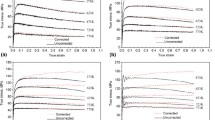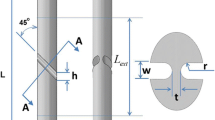Abstract
Precise determination of superplastic flow behavior involves imposing known and controlled strain rate during deformation of these alloys. Examination of tensile specimens after superplastic deformation has revealed variations in strain and strain rate occurring as a function of position and the difficulty of maintaining a constant strain rate during testing. To quantify these strain and strain-rate gradients within the specimens, interrupted tensile tests and tests on gridded tensile specimens were performed. It was observed that more uniform strain and strain rates could be achieved with longer gauge length specimens. While longer gauge lengths make it possible to have better control over the imposed strain rate by minimizing the effects of material flow from the specimen grip regions, it has been realized that for smaller specimen gauge lengths, typically used in most laboratories, a more complex control of crosshead speed (CHS) during a test is essential to characterize superplastic behavior. A mathematical model has been developed in order to gain better insight into this material flow and to provide an improved crosshead control schedule for constant strain-rate testing. The results of this analysis have been validated on a superplastic aluminum-magnesium alloy (5083 Al).
Similar content being viewed by others
References
A.K. Ghosh and C.H. Hamilton:Metall. Trans. A, 1979, vol. 10A, pp. 699–706.
R. Verma, P.A. Friedman, A.K. Ghosh, C. Kim, and S. Kim:Metall. Trans. A, 1996, vol. 27A, pp. 1889–98.
C. Liu and Y. Shi-Gong:Mater. Sci. Techno!., 1990, vol. 6, pp. 141–45.
K.I. Johnson, M.A. Khaleel, C.A. Lavender, S.G. Pitman, J.T. Smith, M.T. Smith, and C.H. Hamilton: inSuperplasticity in Advanced Materials, Materials Science Forum, T.G. Langdon, ed., Trans Tech Publications, Aedermannsdorf, Switzerland, 1994, vols. 170–172, pp. 627–32.
A.K. Ghosh: inSuperplasticity in Advanced Materials, Materials Science Forum, T.G. Langdon, ed., Trans Tech Publications, Aedermannsdorf, Switzerland, 1994, vols. 170–172, pp. 39–46.
A.K. Ghosh and C.H. Hamilton:Metall. Trans. A, 1982, vol. 13A, pp. 733–43.
R.C. Gifkins:Metall. Trans. A, 1976, vol. 7A, pp. 1225–32.
A.K. Ghosh and A. Basu: inCritical Issues in the Development of High Temperature Structural Materials, Proc. TMS Conf., Kona, HI, 1993, N.S. Stoloff, DJ. Duquette, and A.F. Giamei, eds., TMS, Warrendale, PA, 1994, pp. 291–302.
C.H. Hamilton, H.M. Zbib, C.H. Johnson, and S.K. Richter: inSuperplasticity in Advanced Materials, ICSAM ’91, Osaka, Japan, 1991, S. Hori, M. Tokizane, and N. Furushiro, eds., Japan Society for Research on Superplasticity (JSRS), Tokyo, Japan, pp. 127–32.
Author information
Authors and Affiliations
Rights and permissions
About this article
Cite this article
Friedman, P.A., Ghosh, A.K. Control of superplastic deformation rate during uniaxial tensile tests. Metall Mater Trans A 27, 3030–3042 (1996). https://doi.org/10.1007/BF02663852
Received:
Issue Date:
DOI: https://doi.org/10.1007/BF02663852




